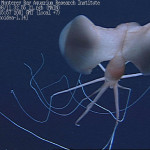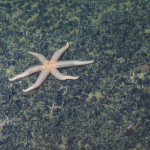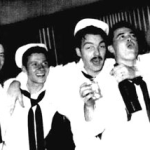It is very early in the morning. Yes I know its only a little after 7am but I really am not a morning person. Like most mornings leaving the dock in Moss Landing it is foggy and relatively cold. I’m not whining its just cold for a southern boy. I will be on the Pt. Lobos today, affectionately referred to by some as the Pt. Puke for its high draft and odd roll but I love her anyway. We will be using the ROV Ventana to visit the ocean floor at approximately 850m.

We have an approximate 2 hour steam and subsequent 1-2 hour wait for the Ventana to reach our seafloor sampling site in Soquel Canyon (yellow star). Soquel Canyon joins up with Monterey Canyon 11 miles offshore. This will be my first time to visit this site. Previously, I have been focusing on the next canyon over, labeled Invert Cliff (red star) for is historically high abundances of large invertebrates (megafauna) like sea cucumbers, urchins, starfish, snails, and fish. The first task will be to deploy a benthic respirometer (picture below) to measure the metabolic (respiration) rate of the microrganisms living in sediment. This is part of larger project to assess how deep-sea animals will react to ocean acidification. The second part of the day we will collect push cores to collect sediment and macrofauna, small organisms living in the sediment, and conduct video transects for megafauna living on the sediment surface. One of research questions I am intersted in focuses on the importance abrupt topography on the seafloor, such as cliff faces, to biological communities of organisms. My previous work at Ivert Cliff, 100m high wall, suggests that at the cliff face detritus, or marine snow, and large kelp falls are concentrated. This in turn appears to increase megafauna abundance at the cliff face. Interesting, the macrofauna at the cliff face appear to be both smaller than normal and less diverse (fewer species). We currently have experiments out at other sites to see if this macrofauna pattern is related to the increase of megafauna near the cliff site. Of course all of this is based on observations at one site. To test the generatlity of these findings we are starting sampling in Soquel Canyon with an equally impressive cliff face.

Now to just sit back, wait, and eat some potato chips.
View from the Pt. Lobos on our way out of Moss Landing Harbor.





